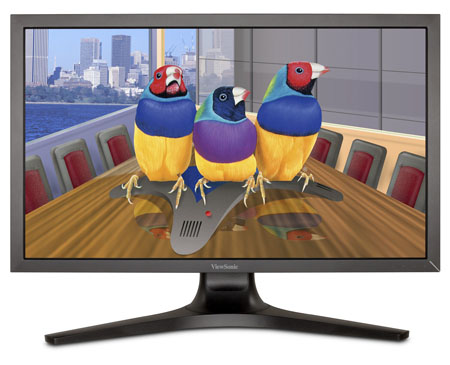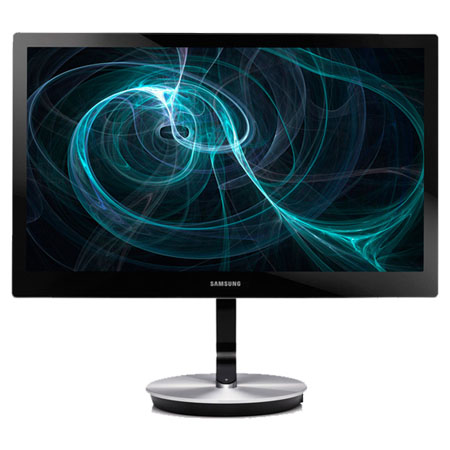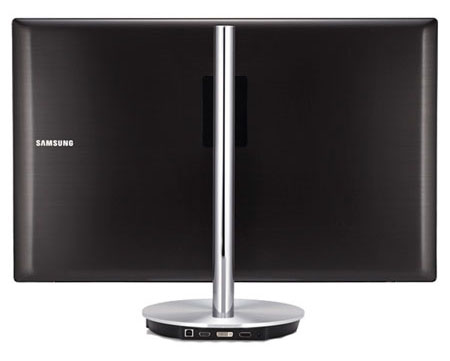VP2770-LED Vs. S27B970D: 27" Monitors At 2560x1440
If you demand maximum pixel density and the highest resolution on your desktop PC, these 27-inch screens from ViewSonic and Samsung do not disappoint. Today, we put ViewSonic's VP2770-LED and Samsung's S27B970D to the test. Is QHD right for you?
ViewSonic VP2770-LED And Samsung S27B970D
There's something to be said for running a Full HD (FHD) display at its native resolution, be it a monitor or HDTV. At 1920x1080, the mainstream adoption of a truly high-definition mode gave us enough screen detail to create film-like picture quality without a glaringly obvious pixel structure. It ushered in a new era where TV and PC content were finally in sync.
But alas, all good things must come to an end, and we know full well that nothing stands still in this business for very long. There is always something better just around the corner. Enter Quad HD (QHD) screens sporting 2560x1440 resolutions. Quad refers to the total number of pixels these displays employ, which is multiplied by the minimum standard for HD: 1280x720. Whereas 720p has a total of 921,600 pixels, QHD has four times that number, or 3,686,400 pixels. This is still a high-end technology though, and monitors sporting QHD resolutions are priced significantly higher than their 1080p counterparts.
It's unfortunate that screens with a 16:10 aspect ratio are becoming as rare as they are, commanding unusually high prices. But the slight loss of vertical resolution you experience on a big 27" monitor running 2560x1440 (corresponding to 16:9) isn't that big of a deal. The greater pixel density means you can sit a little closer to the screen without being bothered by the pixel structure. Both of the monitors we're reviewing today pack 108.8 pixels into every inch, while 27-inch FHD monitors only give you 81.6. By comparison, the 15-inch Apple MacBook with Retina Display has 220 pixels per inch, and the iPhone 5 boasts an incredible 326!
We're looking at flagship models from ViewSonic and Samsung: the VP2770-LED and S27B970D. These are premium products with a price tag to match. When you spend this much, you should expect a high degree of color accuracy, excellent contrast, and plenty of light output. Do these two screens offer more than just extra pixels? Let’s take a look.
ViewSonic VP2770-LED
The VP2770-LED comes securely packaged in a double-layer box. Since you're most likely to purchase this monitor online, its sturdy container is essential. We're glad to see that ViewSonic doesn’t skimp on its bundle either, providing dual-link DVI, DisplayPort, VGA, and USB cables, along with a standard power cord. The setup CD contains all necessary drivers and an electronic copy of the user manual.
This monitor features minimalist industrial styling, with everything enclosed in a matte black non-reflective plastic. The attached base is wide and stable, and it allows for swivel, tilt, rotate, and height adjustment. The bezel is 22 mm wide on all four sides, and the actual image goes right to the edge of the glass, leaving no visible black border. A dark grey ViewSonic logo is stenciled in the center of the bottom bezel. Touch-sensitive menu controls and power button are located to the right of the logo. A small status LED peeks out of the lower-right corner, though it can be disabled in the menu.
Get Tom's Hardware's best news and in-depth reviews, straight to your inbox.
Speaking of the menu, its logically-arranged array of controls will be instantly familiar to anyone who has previously owned a ViewSonic monitor. It’s evident from the start that the VP2770-LED is a very solidly-built piece of gear.
The rear panel includes a complement of downward-facing inputs and a 100x100 mm VESA mount. Four screws detach the base if you want to mount this panel on a wall bracket or swing-arm. Inputs include DVI, HDMI 1.4, DisplayPort, and VGA, though only the DVI and DisplayPort inputs support the panel’s full native resolution. USB is enabled through one Type B uplink, two USB 2.0 ports underneath the monitor, and two USB 3.0 ports on the side. We noticed an audio jack as well, which was a bit of a mystery since there are no speakers built in. As it turns out, this is an output for headphones. It may come in handy if you want to connect a DVD or Blu-ray player via HDMI, since that standard includes an audio signal.
Samsung S27B970D
The new Series 9 panel from Samsung is practically drenched in high-end features and aesthetics. The first thing that falls out of the box is a calibration data sheet with the test results of the monitor inside. That’s right folks, each panel is hand-calibrated at the factory before delivery. Priced at $1,199, however, you pay handsomely for that service. This is the first factory-calibrated display we’ve ever tested, so we’ll see how our own results compare to Samsung’s later on in the benchmarks.
Despite all the attention paid to the S27B970D at the factory, its shipping carton is not quite up to the task of protecting such an expensive piece of hardware, and our sample arrived with a hole in the box. The cardboard is simply too thin. Fortunately, the panel was undamaged thanks to the large amount of empty space inside. We urge online buyers to inspect their purchase promptly. Inside is a full kit of cables, including one for DisplayPort, HDMI (with a Mobile High-Definition Link connector), dual-link DVI, and USB. On this monitor, the power supply is located in an external power brick.
Visually, this is one of the nicest-looking monitors we’ve ever seen. The screen is covered by a glass panel that sits flush with a thin, polished-metal bezel. The image border is 24 mm on the sides and top, and 42 mm across the bottom. The glass has a non-reflective coating, though it’s not quite as effective as the plastic covers used on most displays. Depending on your room lighting, you are likely to see at least some reflections. On the plus side, the image is tack-sharp.
The base is a large silver disk around 1.25"-thick, and it performs double-duty as the housing for the input jacks and touch-sensitive control panel. The display is attached to a slim vertical arm, made of metal, which is adjustable for tilt and height. Unfortunately, there is no swivel or rotation on this unit, and since the base is permanently attached, any sort of bracket mount is also out.
The input complement is all-digital; no VGA option is available. The three included ports are HDMI, DVI, and DisplayPort. The HDMI input doesn’t support the monitor's full native resolution, but that doesn't appear to be its purpose anyway, since it supports MHL, allowing you to hook up a phone or other device to view its output. More and more portable electronics seem to have this feature nowadays, so it’s nice to see it supported on the desktop end. USB 2.0 is supported as well, with a Type B connector on the back and two Type A ports on the screen's right side. You need to connect the rear port to your PC if you want to use the NCE calibration software. More on that later.
| Brand | ViewSonic | Samsung |
|---|---|---|
| Price | $856 MSRP | $1,200 MSRP |
| Model | VP2770-LED | S27B970D |
| Panel Type | IPS | PLS |
| Backlight | LED | LED |
| Screen Size | 27" | 27" |
| Max Resolution | 2560x1440 | 2560x1440 |
| Aspect Ratio | 16:9 | 16:9 |
| Response Time (GTG), mfr | 12 ms | 5 ms |
| Brightness (cd/m2), mfr | 300 | 285 |
| Speakers | No | Yes |
| VGA | 1 | - |
| DVI | 1 | 1 |
| DisplayPort | 1 | 1 |
| HDMI | 1 | 1 |
| Energy Star-Qualified | Yes | Yes |
| Refresh Rate | 60 Hz | 60 Hz |
| Dimensions w/Stand (W x H x D), inches | 25.3 x 18.5 x 13.7 | 25.4 x 18.4 x 9.7 |
| Dimensions w/Stand (W x H x D), millimeters | 642.6 x 464.8 x 348 | 645.2 x 467.4 x 246.4 |
| Warranty | Three years | Three years |
Before we get to the results, let’s go over how we test, and run down some of the unique calibration features of Samsung's S27B970D.
Current page: ViewSonic VP2770-LED And Samsung S27B970D
Next Page Test Setup And The S27B970D's Unique Features
Christian Eberle is a Contributing Editor for Tom's Hardware US. He's a veteran reviewer of A/V equipment, specializing in monitors. Christian began his obsession with tech when he built his first PC in 1991, a 286 running DOS 3.0 at a blazing 12MHz. In 2006, he undertook training from the Imaging Science Foundation in video calibration and testing and thus started a passion for precise imaging that persists to this day. He is also a professional musician with a degree from the New England Conservatory as a classical bassoonist which he used to good effect as a performer with the West Point Army Band from 1987 to 2013. He enjoys watching movies and listening to high-end audio in his custom-built home theater and can be seen riding trails near his home on a race-ready ICE VTX recumbent trike. Christian enjoys the endless summer in Florida where he lives with his wife and Chihuahua and plays with orchestras around the state.
-
mayankleoboy1 ReplyWhy wouldn't you want a QHD screen like one of these two?
Everything gets smaller.
So increase the DPI scaling ?
-
MauveCloud BigMack70I'm glad to see 1440p monitors getting some attention, but I just don't see the prices of these being justifiable to most users over the USA-based Korean 1440p IPS panels that are starting to become more numerous.$800-1200 is just nuts for anyone using these for home use or gaming, IMO.Reply
Agreed. I bought a Dell U2711 a few months ago, but if something forced me to replace it, I'd probably go with one of those cheap Korean panels -- or a TN panel 2560x1440 monitor if somebody would actually make one - I doubt I'm the only one who likes the resolution but isn't so picky about color quality. I had no objection to the color quality on my Samsung P2770HD, and the color shifts of a TN panel are affected by the physical size of the monitor, not the resolution, right? -
Why not do a review on those $330 Korean 1440P monitors that enthusiasts talk about? I like to see what i am missing with the extra $900. Really i'm serious i really want to know what justifies the 1 grand price tag.Reply
-
cangelini jupiter optimus maximusWhy not do a review on those $330 Korean 1440P monitors that enthusiasts talk about? I like to see what i am missing with the extra $900. Really i'm serious i really want to know what justifies the 1 grand price tag.It's coming. We're ramping up our display coverage, so we took note of the requests after the last display piece and put in the requests. You'll see this soon. Of course, if there are any other requests from you guys, do let us know. Christian is doing a phenomenal job of applying his extensive experience on Tom's Hardware.Reply -
EzioAs Dell's UltraSharp U2713HM is less than $600 in my country if we go by standard conversion. Would you guys say that's a good price?Reply -
festerovic cangeliniIt's coming. We're ramping up our display coverage, so we took note of the requests after the last display piece and put in the requests. You'll see this soon. Of course, if there are any other requests from you guys, do let us know. Christian is doing a phenomenal job of applying his extensive experience on Tom's Hardware.That's great to hear, I agree with the others that the price of these models is too much to consider unless they were generating $$$s for me. $3-400 seems like the range I would be willing to spend on these. And as for the USA based korean cheap models, are there any legit retailers of these? Please point me at them.Reply -
JOSHSKORN Just bought a ASUS VS278Q-P for $310. It's a 60Mz monitor and I do game, but I'm happy. My previous monitor lasted 8 years (Samsung SyncMaster 213T, bought it for $1k). I'll upgrade when this one dies, hopefully 4k/UHD will be affordable. Supposedly, only serious gamers can tell the difference between 60Hz and 120Hz. I'm not a serious gamer, so it works just fine for me. 120Hz monitors of that size are nearly twice the price.Reply -
mannam Reply10449443 said:It's coming. We're ramping up our display coverage, so we took note of the requests after the last display piece and put in the requests. You'll see this soon. Of course, if there are any other requests from you guys, do let us know. Christian is doing a phenomenal job of applying his extensive experience on Tom's Hardware.
Here are the inexpensive $300-$400 27" korean monitor brands: Yamakasi Catleap, Achieva Shimian, Crossover, PCBank, Potalion, Auria
"The reason these monitors are cheap - LG makes IPS panels for apple cinema displays. Apple only accepts grade A+ panels. That means the all the grade A,A-,B+, etc are not accepted and returned to LG. LG resells those IPS panels to other manufacturers. You can get the whole story on google if you're interested. In addition, you're getting no support and no manufacturers warranty."
Source: http://www.mmorpg.com/gamelist.cfm?game=239&view=forums&post=5192222#5192222
It would be really interesting to get a review of these monitors that go for 50% or less of the price of the Big Brand stuff. If it's even 85-90% quality compared to the big brands, then they are worth the plunge. :D -
ubercake Personally, I was not impressed with the Auria monitor. My Acer HN274H TN monitor has better contrast. Viewing angles are far better on the Auria, but that's to be expected on an IPS. At any rate, I returned the Auria after a day of use because after many attempts to adjust the contrast/color, it didn't hold a candle to the colors or contrast on my TN. The Auria definitely had deeper black, but the in-betweens seemed to be missing no matter how I set the contrast and color. I honestly couldn't justify the tradeoff of higher resolution to lack of contrast. Maybe I got one of the LG B+ throw-away panels?Reply



